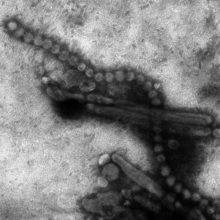This article's factual accuracy may be compromised due to out-of-date information. (December 2020) |
| Influenza A virus subtype H7N9 | |
|---|---|
| Virus classification | |
| (unranked): | Virus |
| Realm: | Riboviria |
| Kingdom: | Orthornavirae |
| Phylum: | Negarnaviricota |
| Class: | Insthoviricetes |
| Order: | Articulavirales |
| Family: | Orthomyxoviridae |
| Genus: | Alphainfluenzavirus |
| Species: | |
| Serotype: | Influenza A virus subtype H7N9
|
| Influenza (flu) |
|---|
 |
Influenza A virus subtype H7N9 (A/H7N9) is a subtype of the influenza A virus, which causes influenza (flu), predominantly in birds. It is enzootic (maintained in the population) in many bird populations.[1] A/H7N9 virus can also infect humans that have been exposed to infected birds; in these cases, symptoms are frequently severe or fatal.[2] A/H7N9 virus is shed in the saliva, mucous, and feces of infected birds.[3] The virus can spread rapidly through poultry flocks and among wild birds.[3]
Symptoms of A/H7N9 influenza vary according to both the strain of virus underlying the infection and on the species of bird or mammal affected.[4][5] Classification as either Low Pathogenic Avian Influenza (LPAI) or High Pathogenic Avian Influenza (HPAI) is based on the severity of symptoms in domestic chickens and does not predict the severity of symptoms in humans.[6] Chickens infected with LPAI A/H7N9 virus display mild symptoms or are asymptomatic, whereas HPAI A/H7N9 causes serious breathing difficulties, a significant drop in egg production, and sudden death.[7]
In humans, A/H7N9 influenza (whether LPAI or HPAI) is rare; it can usually be traced to close contact with infected poultry or contaminated material such as feces.[8] Symptoms of infection vary from mild to severe, including fever, diarrhoea, and cough.[9]
 Electron micrograph of Influenza A (H7N9). | |
| Date | March 31, 2013–present |
|---|---|
| Location | |
| Casualties | |
| 619 deaths (as of 25 October 2017) | |
| 1622 cases (as of 25 October 2017) | |
The H7N9 virus is considered to be enzootic (continually present) in wild aquatic birds, which may carry the virus over large distances during their migration.[11]
The first known case of H7N9 influenza infecting humans was reported in March 2013, in China.[12] Cases continued to be recorded in poultry and humans in China over the course of the next 5 years; between February 2013 and February 2019 there were 1,568 confirmed human cases and 616 deaths associated with the outbreak in China.[13] The outbreak was eventually contained by a vaccination program which commenced in 2017.[14]
- ^ "Influenza (Avian and other zoonotic)". who.int. World Health Organization. October 3, 2023. Retrieved May 6, 2024.
- ^ "Avian Influenza A(H7N9) virus". Food and Agricultural Organization of the United Nations. June 1, 2022. Retrieved July 15, 2024.
- ^ a b "Prevention and Antiviral Treatment of Bird Flu Viruses in People | Avian Influenza (Flu)". cdc.gov. US: Centers for Disease Control. April 19, 2024. Retrieved May 8, 2024.
- ^ "Bird flu (avian influenza)". betterhealth.vic.gov.au. Victoria, Australia: Department of Health & Human Services. Retrieved May 9, 2024.
- ^ "Avian influenza: guidance, data and analysis". gov.uk. November 18, 2021. Retrieved May 9, 2024.
- ^ "Avian Influenza in Birds". cdc.gov. US: Centers for Disease Control and Prevention. June 14, 2022. Retrieved May 6, 2024.
- ^ "Bird flu (avian influenza): how to spot and report it in poultry or other captive birds". gov.uk. UK: Department for Environment, Food & Rural Affairs and Animal and Plant Health Agency. December 13, 2022. Retrieved May 6, 2024.
- ^ Cite error: The named reference
5 April 2013 WHO FAQwas invoked but never defined (see the help page). - ^ "Avian influenza: guidance, data and analysis". gov.uk. November 18, 2021. Retrieved May 9, 2024.
- ^ "H7N9 Case Detected in Malaysia". CDC. February 12, 2014. Archived from the original on June 27, 2017. Retrieved February 18, 2014.
Still no sustained human-to-human spread; risk assessment unchanged
- ^ Joseph U, Su YC, Vijaykrishna D, Smith GJ (January 2017). "The ecology and adaptive evolution of influenza A interspecies transmission". Influenza and Other Respiratory Viruses. 11 (1): 74–84. doi:10.1111/irv.12412. PMC 5155642. PMID 27426214.
- ^ Cite error: The named reference
Naturewas invoked but never defined (see the help page). - ^ CDC (June 3, 2024). "2010-2019 Highlights in the History of Avian Influenza (Bird Flu) Timeline". Avian Influenza (Bird Flu). Retrieved July 16, 2024.
- ^ "Risk assessment of avian influenza A(H7N9) – eighth update". UK Health Security Agency. January 8, 2020. Retrieved July 15, 2024.